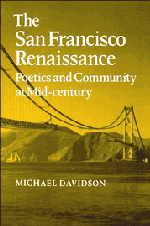4 - “Cave of Resemblances, Cave of Rimes”
Tradition and Repetition in Robert Duncan
Published online by Cambridge University Press: 01 June 2011
Summary
TRADITION AND THE HERETICAL TALENT
Robert Duncan always insisted that the renaissance of San Francisco writing had its basis not in the North Beach milieu of the mid-1950s but in the group of writers who met around him in Berkeley during the late 1940s. The “Berkeley Renaissance” represented, for young poets like Duncan, Jack Spicer, and Robin Blaser, the first flowering of a Bay Area literary community based less on region than on coterie spirit. Writing to Blaser in 1957 following the publication of the “San Francisco Scene” issue of Evergreen, Duncan makes this distinction clear: “It's just that by some damnd incident of geography I am so solidly placed in region, and not in coterie. And I'm a coterie poet not a regional one.” The acknowledgment of such a coterie spirit would seem to reinforce Charles Olson's accusation that the San Francisco scene had become an “école des Sages ou Mages” like the theosophical community in Ojai, California. Duncan did not share Olson's localist ethos, preferring instead an almost cultic sense of group identity. His enabling myth of poetic community was based less on the accidents of proximity or the lures of region than on the revival of heretical traditions within a brotherhood of loyal believers. That this brotherhood was often homosexual was no small feature of Duncan's projection.
The paradox of Duncan's antiregionalist remarks is that of the writers considered in this book, he is the only one native to the area.
- Type
- Chapter
- Information
- The San Francisco RenaissancePoetics and Community at Mid-Century, pp. 125 - 149Publisher: Cambridge University PressPrint publication year: 1989



